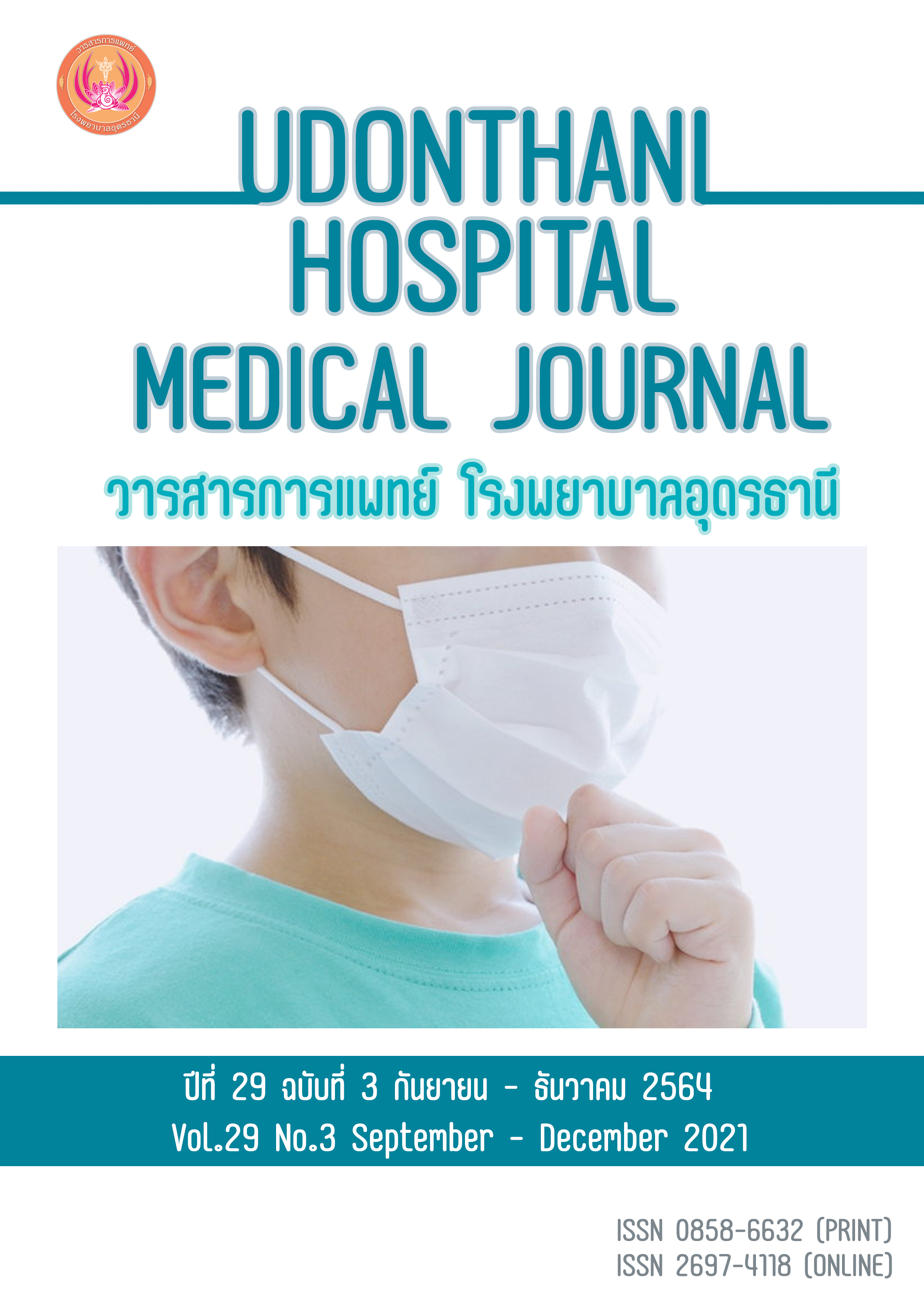ความชุกและปัจจัยที่เกี่ยวข้องกับการเกิดความดันโลหิตต่ำหลังการให้ยาชาทางช่องน้ำไขสันหลังในผู้สูงอายุที่เข้ารับการผ่าตัดที่โรงพยาบาลมหาราชนครราชสีมา
คำสำคัญ:
การให้ยาชาทางช่องไขสันหลัง, การผู้สูงอายุ, ความดันโลหิตต่ำบทคัดย่อ
การเกิดความดันโลหิตต่ำหลังจากการระงับความรู้สึกแบบให้ยาชาเข้าทางช่องน้ำไขสันหลังเป็นภาวะที่เกิดขึ้นบ่อย และส่งผลแทรกซ้อนมากมาย รวมไปถึงการเพิ่มอัตราการเสียชีวิตหลังผ่าตัดโดยเฉพาะอย่างยิ่งในผู้ป่วยสูงอายุ ดังนั้นหากเราทราบปัจจัยเสี่ยงของการเกิดภาวะดังกล่าว น่าจะมีประโยชน์ในการป้องกันการเกิดภาวะแทรกซ้อนได้ จุดมุ่งหมายของการศึกษานี้เป็นการประเมินความชุกและปัจจัยเสี่ยงของความดันโลหิตต่ำหลังจากการฉีดยาชาทางช่องน้ำไขสันหลังในผู้ป่วยสูงอายุที่มารับการผ่าตัด ซึ่งเป็นการศึกษาย้อนหลังในผู้ป่วยทุกคนที่มีอายุตั้งแต่ 65 ปีขึ้นไปที่มารับการผ่าตัดโดยได้รับการระงับความรู้สึกแบบฉีดยาชาทางช่องไขสันหลัง ระหว่างเดือนตุลาคม 2562 ถึง มิถุนายน 2563 ณ โรงพยาบาลมหาราชนครราชสีมา ข้อมูลที่เก็บรวบรวมจากเวชระเบียนผู้ป่วยในประกอบด้วยข้อมูลทั่วไปของผู้ป่วยได้แก่ เพศ อายุ โรคประจำตัว, ผลทางห้องปฏิบัติการ, สัญญาณชีพ, ปริมาณสารน้ำที่ได้รับก่อนได้รับยาชา, ชนิดและปริมาณยาชา วิเคราะห์ข้อมูลแบบ multiple logistic regression และแสดงผลด้วย adjusted odd ratio และ p-value
ผลการศึกษา ผู้ป่วยสูงอายุที่มารับการผ่าตัดจำนวน 419 คน อายุเฉลี่ย 74.3 ปี เกิดภาวะความดันเลือดต่ำหลังจากการได้รับยาชาทางช่องไขสันหลัง จำนวน 171 คน คิดเป็นร้อยละ 40.8 โดยพบว่า ผู้ป่วยที่มีโรคหัวใจขาดเลือด (OR 3.94, 95% CI 1.71-10.07, p=0.002) ผู้ป่วยที่มีความดันโลหิตซิสโตลิกก่อนการผ่าตัดต่ำกว่า 140 มิลลิเมตรปรอท (OR 1.61, 95% CI 1.71-2.86, p=0.029) และผู้ป่วยที่มีค่าฮีโมโกลบินเริ่มต้นน้อยกว่า 12 กรัมต่อเดซิลิตร [(Hb<10: OR 5.32, 95% CI 2.45-14.1, p<0.001), (Hb 10-11.9: OR 1.75, 95% CI 1.17-3.08, p=0.019)] มีความสัมพันธ์กับการเกิดภาวะความดันโลหิตต่ำหลังได้รับการฉีดยาชาทางช่องน้ำไขสันหลังอย่างมีนัยสำคัญทางสถิติ (p-value <0.05)
ข้อเสนอแนะ ควรมีการเฝ้าระวังมากเป็นพิเศษในการเกิดความดันโลหิตต่ำในผู้สูงอายุที่มีความเสี่ยงคือ มีโรคประจำตัวเป็นโรคหัวใจขาดเลือด ความดันโลหิตซิสโทลิกก่อนการผ่าตัดต่ำกว่า 140 มิลลิเมตรปรอท และผู้ป่วยที่มีค่าฮีโมโกลบินพื้นฐานน้อยกว่า 12 กรัมต่อเดซิลิตร อีกทั้งควรแก้ไขภาวะซีดโดยการให้เลือดในผู้สูงอายุที่มีค่าฮีโมโกลบินพื้นฐานน้อยกว่า 12 กรัมต่อเดซิลิตร ตั้งแต่ก่อนเข้าสู่กระบวนการผ่าตัดโดยได้รับการระงับความรู้สึกเพื่อการผ่าตัดโดยการฉีดยาชาเข้าช่องน้ำไขสันหลัง เพื่อลดการเกิดภาวะแทรกซ้อนจากความดันโลหิตต่ำ
เอกสารอ้างอิง
2. Park WY, Thompson JS, Lee KK. Effect of epidural anesthesia and analgesia on perioperative outcome: a randomized, controlled Veterans Affairs cooperative study. Annals of surgery 2001; 234(4): 560.
3. Cook P, Davies M, Cronin K, Moran P. A prospective randomised trial comparing spinal anaesthesia using hyperbaric cinchocaine with general anaesthesia for lower limb vascular surgery. Anaesthesia and Intensive Care 1986; 14(4): 373-80.
4. Hofhuizen C, Lemson J, Snoeck M, Scheffer G-J. Spinal anesthesia-induced hypotension is caused by a decrease in stroke volume in elderly patients. Local Reg Anesth 2019; 12: 19–26.
5. Carpenter RL, Caplan RA, Brown DL, Stephenson C, Wu R. Incidence and risk factors for side effects of spinal anesthesia. Anesthesiology 1992; 76(6): 906–916.
6. Lairez O, Ferre F, Portet N, Marty P, Delmas C, Cognet T, et al. Cardiovascular effects of low-dose spinal anesthesia as a function of age: An observational study using echocardiography. Anaesth Crit Care Pain Med 2015; 34(5): 271-6.
7. Hartmann B, Junger A, Klasen J, Benson M, Jost A, Banzhaf A, et al. The incidence and risk factors for hypotension after spinal anesthesia induction: an analysis with automated data collection. Anesth Analg 2002; 94(6): 1521-9.
8. Olofsson C, Nygards EB, Bjersten AB, Hessling A. Low-dose bupivacaine with sufentanil prevents hypotension after spinal anesthesia for hip repair in elderly patients. Acta Anaesthesiologica Scandinavica 2004; 48(10): 1240-4.
9. Nakasuji M, Suh SH, Nomura M, Nakamura M, Imanaka N, Tanaka M, et al. Hypotension from spinal anesthesia in patients aged greater than 80 years is due to a decrease in systemic vascular resistance. Journal of Clinical Anesthesia 2012; 24(3): 201-6.
10. Jang WY, Jung JK, Lee DK, Han SB. Intraoperative hypotension is a risk factor for postoperative acute kidney injury after femoral neck fracture surgery: a retrospective study. BMC Musculoskelet Disord 2019; 20: 131.
11. Walsh M, Devereaux PJ, Garg AX, Kurz A, Turan A, Rodseth RN, et al. Relationship between intraoperative mean arterial pressure and clinical outcomes after noncardiac surgery toward an empirical definition of hypotension. Anesthesiology: The Journal of the American Society of Anesthesiologists 2013; 119(3): 507-15.
12. Meyhoff CS, Haarmark C, Kanters JK, Rasmussen LS. Is it possible to predict hypotension during onset of spinal anesthesia in elderly patients Journal of Clinical Anesthesia 2009; 21(1): 23-9.
13. Critchley LA, Stuart JC, Short TG, Gin T. Haemodynamic effects of subarachnoid block in elderly patients. Br J Anaesth 1994; 73(4): 464-470.
14. Salinas FV, Sueda LA, Liu SS. Physiology of spinal anaesthesia and practical suggestions for successful spinal anaesthesia. Best Practice & Research Clinical Anaesthesiology 2003; 17(3): 289-303.
15. Roshanov PS, Sheth T, Duceppe E, Tandon V, Bessissow A,Chan MT, et al. Relationship between perioperative hypotension and perioperative cardiovascular events in patients with coronary artery disease undergoing major noncardiac surgery. Anesthesiologists 2019; 130(5): 756-66.
16. ราชวิทยาลัยวิสัญญีแพทย์แห่งประเทศไทย. แนวทางเวชปฏิบัติในการทำ Spinal Anesthesia ปี พ.ศ.2562. กรุงเทพฯ: ราชวิทยาลัย; 2562.
17. Critchley LAH. Hypotension, subarachnoid block and the elderly patient. Anesthesia 1996; 51(12): 1139-43.
18. Martyr JW, Clark MX. Hypotension in elderly patients undergoing spinal anesthesia for repair of fractured neck of femur. A comparison of two different spinal solutions. Anesthesia and Intensive Care 2001; 29(5): 501-5.
19. Marhofer P, Faryniak B,Oismuller C, Koinig H, Kapral S, Mayer N. Cardiovascular effects of 6%hetastarch and lactated Ringer’s solution during spinal anesthesia. Regional anesthesia and Pain Medicine 1999; 24(5): 399-404.
20. Chinachoti T, Tritrakarn T. Prospective study of hypotension and bradycardia during spinal anesthesia with bupivacaine: incidence and risk factors, part two. J Med Assoc Thai 2007; 90: 492-501.
21. Tarkkila P, Isola J. A regression model for identifying patients at high risk of hypotension, bradycardia and nausea during spinal anesthesia. Acta Anaesthesiol Scand 1992; 36(6): 554-8.
22. Kyokong O, Charuluxananan S, Sriprajittichai P, Poomseetong T, Naksin P. The incidence and risk factors of hypotension and bradycardia associated with spinal anesthesia. J Med Assoc Thai 2006; 89(Suppl 3): S58-64.
23. Moller JE, Pellikka PA, Hillis GS, Oh JK. Prognostic importance of diastolic function and filling pressure in patients with acute myocardial infarction. Circulation 2006; 114(5): 438-444.
24. Metivier F, Marchais SJ, Guerin AP, Pannier B, London GM. Pathophysiology of anemia: focus on the heart and blood vessels. Nephrol Dial Transplant 2000; 15(Suppl 3): 14-18.
ดาวน์โหลด
เผยแพร่แล้ว
รูปแบบการอ้างอิง
ฉบับ
ประเภทบทความ
สัญญาอนุญาต
การละเมิดลิขสิทธิ์ถือเป็นความรับผิดชอบของผู้ส่งบทความโดยตรง
ผลงานที่ได้รับการตีพิมพ์ถือเป็นลิขสิทธิ์ของผู้นิพนธ์ ขอสงวนสิทธิ์มิให้นำเนื้อหา ทัศนะ หรือข้อคิดเห็นใด ๆ ของบทความในวารสารไปเผยแพร่ทางการค้าก่อนได้รับอนุญาตจากกองบรรณาธิการ อย่างเป็นลายลักษณ์อักษร



